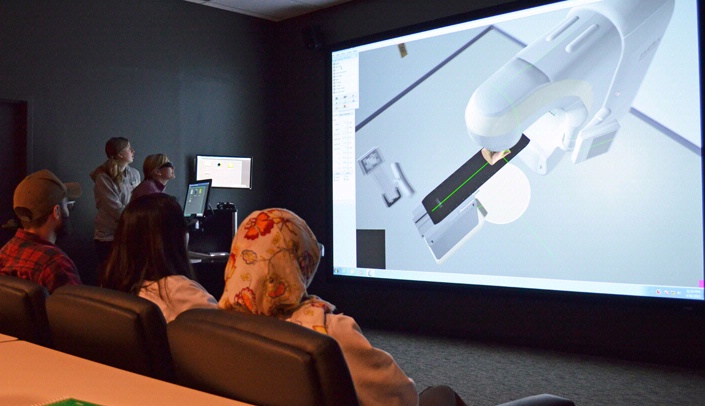As UNMC continues to plan and emphasize iEXCEL℠ interprofessional, experiential education programs for the near future, some on campus are already leading the charge.
At the School of Allied Health Professions, for example, students from the cytotechnology and radiation therapy programs came together recently for an interprofessional education (IPE) program featuring their respective virtual teaching tools.
The effort was led by Amber Donnelly, Ph.D., program director, and Maheswari (Manju) Mukherjee, Ph.D., educational coordinator of cytotechnology, and Jana Koth, clinical education coordinator of radiation therapy. But it was the students themselves who used the technology to show their counterparts what their respective professions do, and how they will fight cancer together.
It’s nothing new for the SAHP.
“Dr. (Kyle) Meyer’s unit has embraced educational innovation and integrated it into the very culture of the college,” said Howard Liu, M.D., director of faculty development.
“This type of exchange is not only an excellent example of IPE, but showcases our new teaching technologies,” said Dr. Meyer, senior associate dean of the SAHP. On July 1, the school will become the College of Allied Health Professions.
UNMC’s cytotechnology program is a national leader in the use of virtual microscopy, in which “slides” can be stored and displayed digitally on a computer and then a larger screen rather than a microscope.
A handful of cytotechnology students used the technology to show their counterparts how cytotechnologists use locating skills and interpretation skills to identify the abnormal cells that make up the tumors radiation therapists will later treat.
“And that,” cytotechnology student Rafat Hamoh said in conclusion, “is where you guys come into play.”
The radiation therapy students then took the group to McGoogan Library, where the VERT (Virtual Environment Radiotherapy Training system) is housed. Likened to a flight simulator, the VERT is a 3-D, “fully immersive” experience featuring brand-specific equipment and any number of medical scenarios within which to work.
With the technology, students not only practice clinical skills, but can actually “see” inside the patient with 3-D cross-sectional anatomy.
The radiation therapy students used the VERT to show the future cytotechnologists how radiation is used to treat the patients who were first screened and identified by cytotechnologists.
It’s valuable to the students, Hamoh said, to see where each profession’s contribution fits and to follow what happens to the patient along the way.
It helps remind them: “Our main job,” he said, “is saving lives.”

The College of Allied Health has been on the leading edge of experiential and interprofessional learning on campus, and this exchange between the cytotechnology and radiation therapy programs is an excellent illustration of that.
This is a great example of how interprofessional education experiences developed at a grass roots level can contribute to the campus strategic plan of promoting IPE. It also demonstrates the increasing role that advanced simulation technology will have in enhancing student learning across disciplines. Congratulations to Amber, Manju, Jana and our students for this pioneering effort!